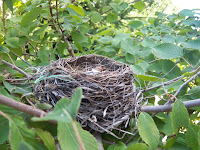Sunday, September 2, 2012
Hydrophobic!
Hydrophobic means that something is repellant to water or fails to mix with water. A hydrophobe is someone who is afraid of water.
An example of something that is hydrophobic is a wasp nest. In nest construction, wasps use an oral secretion to cement together nest material. Nests are water-resistant due to the saliva-cellulose matrix.
Thursday, August 30, 2012
CAM Plant!
CAM, crassulacean acid metabolism, is a carbon fixation pathway that evolved in some plants as an adaption to arid conditions.
Monday, August 27, 2012
Radial Symmetry!
Tropism!
Tropism is when an organsim involuntarily turns or curves by movement or differential growth. An example of tropism is when a tree is growing on a slant or a plant has a curve in its steem.
Wednesday, August 8, 2012
Monocots Vs. Dicots!
Distinguishing characteristics between Monocots Vs. Dicots in a Plant
Flower: Monocots - parts made in multiples of 3's. Ex - Lilies
Dicots - parts made in multiples of 4/5's, diverse. Ex - Morning Glories
Leaves: Monocots - maintain shape, size & length, parallel primary veins.
Dicots - leaves vary, web-like veins.
Seeds/Fuits: Monocots - similar sized and shape.
Dicots - various sizes and shapes.
Stem: Monocots - weak stems.
Dicots - strong steams.
Roots: Monocots - fibrous roots.
Dicots - tap-root system; one strong, central root assisted by smaller roots.
These pictures are examples of a monocot and a dicot because one flower has 3 petals, like a monocot, and one flower has 5 petals, like a dicot.
Dicots - parts made in multiples of 4/5's, diverse. Ex - Morning Glories
Leaves: Monocots - maintain shape, size & length, parallel primary veins.
Dicots - leaves vary, web-like veins.
Seeds/Fuits: Monocots - similar sized and shape.
Dicots - various sizes and shapes.
Stem: Monocots - weak stems.
Dicots - strong steams.
Roots: Monocots - fibrous roots.
Dicots - tap-root system; one strong, central root assisted by smaller roots.
These pictures are examples of a monocot and a dicot because one flower has 3 petals, like a monocot, and one flower has 5 petals, like a dicot.
Monday, August 6, 2012
Glycogen!
When one comsumes carbohydrates, a source of energy, the carbohydrates break down into smaller sugars; glucose, fructose, and galactose, which get absorbed and used as energy. Any glucose not needed right away gets stored in the muscles and the live in the form of glycogen. Glycogen is the source of energy most often used for excersise.
The hotdog bun with spaghetti is an example of carbohydrates because bread and pasta are full of carbs which break down into smaller sugars.
Endosperm!
Endosperm is the tissue produced inside the seeds of most flowering plants around the time of fertilization. It surrounds the embryo and provides nutrition in the form of starch, though it can also contain oils and protein. Endosperm is an important source of nutrience in a persons diet. Flower is grounded endosperm and rice is solid endosperm.
Asexual Reproduction!
Asexual reproduction is when one individual organism can produce offspring that are genetically identical to itself. This is an example of asexual reproduction because the plant reproduces serveral buds that produces indentical flowers.
Amniotic Egg!
Subscribe to:
Posts (Atom)






.JPG)


